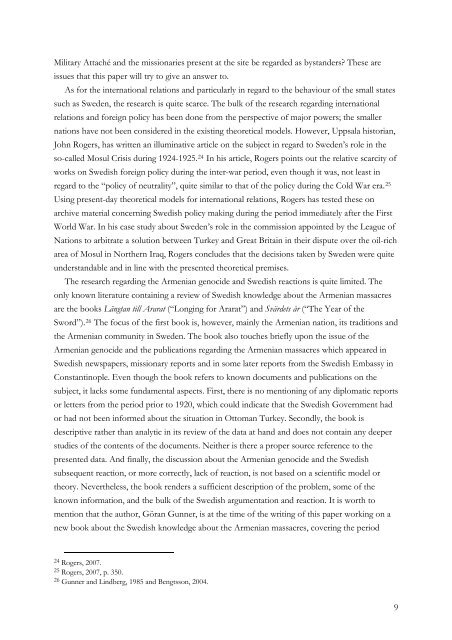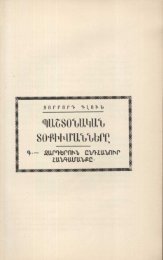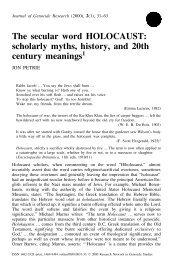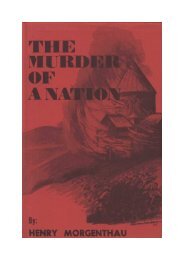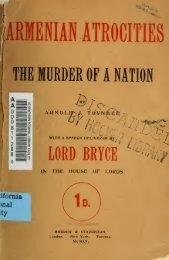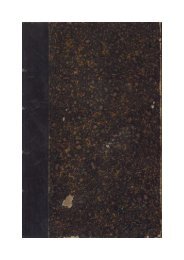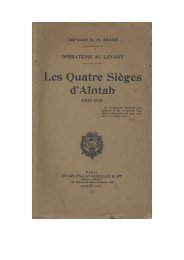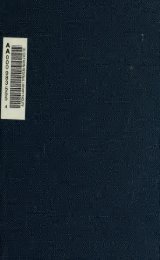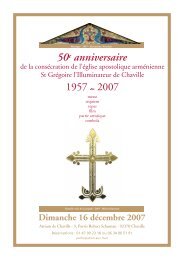the Government suspected of collaborations with the enemy, i.e. as a fifth column, thus justifyingthe measures; and finally, they were the result of the inability of the Turkish Government tohandle the deportations properly once they were implemented. 17 These views, however, arerejected and refuted by a wide range of researchers. The Turkish Government was in full controlof the situation in Ott<strong>om</strong>an Turkey and aware of the obvious consequences of its actions. Thedeportations, in spite of the well-known shortage of resources, were de facto a death sentence. 18The ideology of the new masters of Turkey, the leaders of Ittihad ve Terakki (Union and Progress),also known as “Young Turks”, is yet another factor which several researchers stress as one of thekey instigators behind the annihilation plan of the obstacle in the way of the Pan Turanism,creating a new Turkish Empire. 19 The rhetoric of trying to place the Armenian and Muslimparticipants in the event on same level is misleading since the Armenian civilians can not beregarded as equals to the Turkish Government and Military organization and forces. 20 Thesystematic planning and implementation, as well as the general mobilization of the entire societyas participants in the massacres (i.e. a state-orchestrated action) are factors which researchers usewhen classifying the event as genocide. 21Approaching the problem fr<strong>om</strong> a bystander’s point of view, one could use the theoreticalfoundations laid by the research about the Holocaust. Most of the literature about bystanders andthe analysis of their behaviour are written in regard to the Holocaust and its specific factors, suchas anti-Semitism. Notwithstanding, the specific issues studied in the Jewish case are quiteapplicable to the Armenian case. The c<strong>om</strong>parisons made between the Armenian and Jewishgenocides confirm the assertion of these two having more in c<strong>om</strong>mon than the opposite. 22 It isthis author’s belief that the bystander group is a highly underestimated factor in the study ofgenocide, which rather focuses on the <strong>min</strong>ority actors, the perpetrator and the victim, whileignoring the majority who unconsciously or deliberately choose not to intervene and just bewitnesses to the regrettable horrors c<strong>om</strong>mitted in front of their very eyes. S<strong>om</strong>e were unaware ofthe ongoing atrocities, but sooner or later, the c<strong>om</strong>munication means of the 20 th centuryinformed the bystander about the actions of the perpetrators. Fr<strong>om</strong> that m<strong>om</strong>ent on thebystander had a clear choice how to act. According to Raya Cohen, in the Armenian case, theGermans were considered as bystanders who did know about the annihilation and had the powerto stop their ally, but refrained to do so. 23 What about other nations who knew, but did not act atall? Could e.g. Sweden be regarded as a bystander? Should only the Swedish Ambassador, the17 For these views see, among others, Lewy, 2005 and Mango, 2004.18 Dadrian, 2004, p. 243.19 Akçam, 2006, p. 92-93; Astourian, 1992, p. 68; Chalk and Jonassohn, 1990, p. 259; Graber, 1996, p. 93-97;Melson, 1992, p. 138-139; Moranian, 1992, p. 106; Staub, New Jersey, 2002, p. 19.20 Melson, 1992, p. 154-155; Chalk and Jonassohn, 1990, 273.21 Akçam, 2006, p. 168, 171; Alvarez, 2001, p. 49, 89; Bauer, 2001, p. 37; Chalk and Jonassohn, 1990, p. 260;Graber, 1996, p. 109; Schabas, 2000, p. 196; Shaw, 2003, p. 32; Weitz, 2003, p. 2.22 Auron, 2002; Dadrian, 1996; Hovannisian, 1999; Melson, 1992.23 Cohen, 2002, p. 153.8
Military Attaché and the missionaries present at the site be regarded as bystanders? These areissues that this paper will try to give an answer to.As for the international relations and particularly in regard to the behaviour of the small statessuch as Sweden, the research is quite scarce. The bulk of the research regarding internationalrelations and foreign policy has been done fr<strong>om</strong> the perspective of major powers; the smallernations have not been considered in the existing theoretical models. However, Uppsala historian,John Rogers, has written an illu<strong>min</strong>ative article on the subject in regard to Sweden’s role in theso-called Mosul Crisis during 1924-1925. 24 In his article, Rogers points out the relative scarcity ofworks on Swedish foreign policy during the inter-war period, even though it was, not least inregard to the “policy of neutrality”, quite similar to that of the policy during the Cold War era. 25Using present-day theoretical models for international relations, Rogers has tested these onarchive material concerning Swedish policy making during the period immediately after the FirstWorld War. In his case study about Sweden’s role in the c<strong>om</strong>mission appointed by the League ofNations to arbitrate a solution between Turkey and Great Britain in their dispute over the oil-richarea of Mosul in Northern Iraq, Rogers concludes that the decisions taken by Sweden were quiteunderstandable and in line with the presented theoretical premises.The research regarding the Armenian genocide and Swedish reactions is quite limited. Theonly known literature containing a review of Swedish knowledge about the Armenian massacresare the books Längtan till Ararat (“Longing for Ararat”) and Svärdets år (“The Year of theSword”). 26 The focus of the first book is, however, mainly the Armenian nation, its traditions andthe Armenian c<strong>om</strong>munity in Sweden. The book also touches briefly upon the issue of theArmenian genocide and the publications regarding the Armenian massacres which appeared inSwedish newspapers, missionary reports and in s<strong>om</strong>e later reports fr<strong>om</strong> the Swedish Embassy inConstantinople. Even though the book refers to known documents and publications on thesubject, it lacks s<strong>om</strong>e fundamental aspects. First, there is no mentioning of any dipl<strong>om</strong>atic reportsor letters fr<strong>om</strong> the period prior to 1920, which could indicate that the Swedish Government hador had not been informed about the situation in Ott<strong>om</strong>an Turkey. Secondly, the book isdescriptive rather than analytic in its review of the data at hand and does not contain any deeperstudies of the contents of the documents. Neither is there a proper source reference to thepresented data. And finally, the discussion about the Armenian genocide and the Swedishsubsequent reaction, or more correctly, lack of reaction, is not based on a scientific model ortheory. Nevertheless, the book renders a sufficient description of the problem, s<strong>om</strong>e of theknown information, and the bulk of the Swedish argumentation and reaction. It is worth t<strong>om</strong>ention that the author, Göran Gunner, is at the time of the writing of this paper working on anew book about the Swedish knowledge about the Armenian massacres, covering the period24 Rogers, 2007.25 Rogers, 2007, p. 350.26 Gunner and Lindberg, 1985 and Bengtsson, 2004.9
- Page 3 and 4: 1 Introduction.....................
- Page 5 and 6: War, rather confirm the version of
- Page 7: 1.2 Previous ResearchWhen discussin
- Page 11 and 12: situation: “It is a crime when Te
- Page 13 and 14: in the following investigation, whi
- Page 15 and 16: killed. The slaughterer slaughtered
- Page 17 and 18: interests. Despite his famous “14
- Page 19 and 20: morality, balance of power, or the
- Page 21 and 22: 4. International organisations (e.g
- Page 23 and 24: warring parties. 104 This observati
- Page 25 and 26: Concerning the protocols of the Swe
- Page 27 and 28: present in Turkey. These documents
- Page 29 and 30: He also mentions meeting an Armenia
- Page 31 and 32: the annihilation. General von Losso
- Page 33 and 34: 1.5 BackgroundIn order to understan
- Page 35 and 36: 1914, when two inspector-generals f
- Page 37 and 38: to Islam or were sold as slaves to
- Page 39 and 40: 2 Empirical AnalysisThe empirical r
- Page 41 and 42: It does not seem to be the Turkish
- Page 43 and 44: The Turks claim that, at the Russia
- Page 45 and 46: The Armenian population has equippe
- Page 47 and 48: 1917 was the revival year for the A
- Page 49 and 50: Even if the communication between t
- Page 51 and 52: implemented against the Armenian na
- Page 53 and 54: Anckarsvärd continued claiming tha
- Page 55 and 56: Germany is blamed for its accessory
- Page 57 and 58: Here Wirsén took the liberty to co
- Page 59 and 60:
On February 19, news of new Armenia
- Page 61 and 62:
estricted to the fields of intrigue
- Page 63 and 64:
generous offer of President Wilson
- Page 65 and 66:
Lange gave a detailed description o
- Page 67 and 68:
skin was totally scorched. Another
- Page 69 and 70:
which her recurrently emphasised th
- Page 71 and 72:
The sooner calls referring to the A
- Page 73 and 74:
Despite these facts, Armenia was th
- Page 75 and 76:
Svenska Riksarkivet [Swedish Nation
- Page 77 and 78:
Bakhtiari, Kalla det vad fan du vil
- Page 79 and 80:
Chan, Steve and Drury, Cooper A., S
- Page 81 and 82:
Moranian, Suzanne Elizabeth, Bearin


